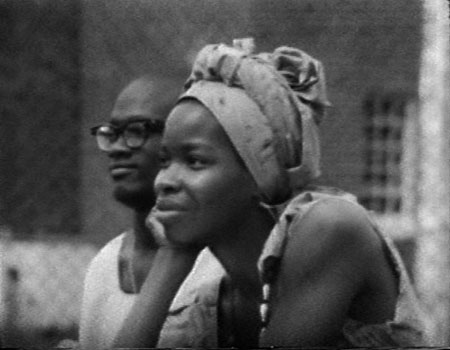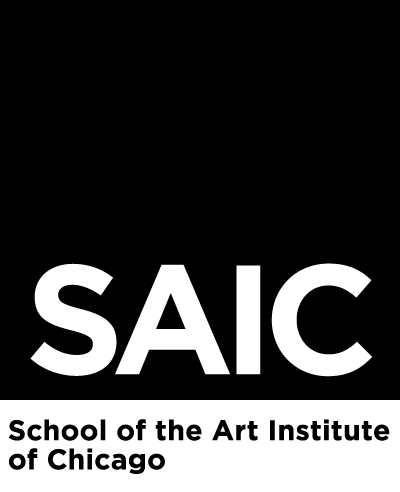Surveying the First Decade: Video Art and Alternative Media in the U.S.
Posted by | Conversations at the Edge | Posted on | April 7, 2009
Thursday, April 9, 6pm | Curator Chris Hill in person!

- People’s Communications Network, Queen Mother Moore Speech at Greenhaven Prison (1973). Image courtesy of the Video Data Bank.
In 1995, the Video Data Bank published “Surveying the First Decade,” a massive, 16-hour anthology of nearly 70 titles from artists and media-makerswho defined the first decade of video art. Curated by Chris Hill, then curator at Hallwalls Contemporary Art Center, the anthology is widely acclaimed for an expansive and revelatory vision that positions works by grassroots activists alongside those by established artists. This evening, to celebrate the VDB’s re-release of “Survey” on DVD, Hill illuminates the medium’s roots in the tumultuous artistic, cultural, and political practices of the 1970s and her efforts to capture the scene twenty years later. The program includes rare public screenings of the collection’s most revealing videos, including: Switch! Monitor! Drift! (Steina Vasulka, 1976); Queen Mother Moore Speech at Greenhaven Prison (People’s Communications Network, 1973); Boomerang (Richard Serra & Nancy Holt, 1974); The Red Tapes, Part II (Vito Acconci, 1976). Co-presented by the Video Data Bank. TRT: ca 75 min.
——
Boomerang
Richard Serra with Nancy Holt, US, 1974, Beta SP video, 11 min., excerpt
This is a tape which analyzes its own discourse and processes as it is being formulated. The language of Boomerang, and the relation between the description and what is being described, is not arbitrary. Language and image are being formed and revealed as they are organized. (VDB)
Switch! Monitor! Drift!
Steina Vasulka, US, 1976, Beta SP video 4 min.
Switch! Monitor! Drift! is one of a series of “machine visions” constructed by Steina in the ’70s. In this documentation of a studio landscape, two cameras’ signals are combined through a luminance keyer. One camera is mounted on a turntable; the second camera is pointed at the first. The image from the stationary camera is time-base adjusted so that it appears to drift horizontally across the monitor, exposing the horizontal framing interval, a black (low voltage) area that is normally hidden from view. The signal of the revolving camera is keyed into this area. The revolving second camera continuously pans the studio, occasionally revealing Steina walking around and flipping a directional switch at the turntable. As the tape progresses the luminance key is adjusted to include a broader tonal range through which the signal from the revolving camera is increasingly visible. (VDB)
The Red Tapes Part II
Vito Acconci, US, 1976, Beta SP video, 60 min., excerpt
The Red Tapes is a three-part epic that features the diary musings of a committed outsider: revolutionary, prisoner, artist. The series offers a fragmented mythic narrative and a poetic reassessment of the radical social and aesthetic aspirations of the previous decade. Acconci maps a “topography of the self,” constructing scenes that suggest both the intimate video space of close-up and the panoramic landscape of film space. The production of The Red Tapes involved painters and filmmakers Erika Beckman, Ilona Granet, Richie O’Halloran, Kathy Rusch, David Salle, and Michael Zwack. (VDB)
Queen Mother Moore Speech at Greenhaven Prison
People’s Communications Network, US, 1973, Beta SP video, 18 min., excerpt
Two years after the riots and deaths at Attica, New York, a community day was organized at Greenhaven, a federal prison in Connecticut. Think Tank, a prisoners’ group, coordinated efforts with African-American community members outside the prison walls to fight racism and poverty. The event was documented by People’s Communication Network, a community video group founded by Bill Stephens, for cablecast in New York City, marking the first time an alternative video collective was allowed to document an event inside prison walls. Seventy-five-year-old Queen Mother Moore speaks of her support of Marcus Garvey in New Orleans and her involvement with African-American education in Brooklyn. Her powerful delivery of lessons in black history, first-person accounts of resistance in the South, and finally her own a cappella performance of “This country ’tis to me, a land of misery…,” is a testament to the importance of people using media to document their own communities and tell their own histories. This tape was found in the Antioch College (Yellow Springs, Ohio) Free Library, a media access resource project organized in late 1966 by students interested in networking with social movements and media activists around the country. (VDB)
——
Chris Hill is a media curator and educator. She served on the Media Arts faculty at Antioch College from 1997 through its close in 2008. Prior to Antioch, she served as Video Curator at Hallwalls Contemporary Arts Center in Buffalo, NY where she also presided over the Board of BCAM, the city’s public access cable TV facility. She is currently on the faculty and Executive Collective of the Nonstop Institute, a liberal arts educational project started in the wake of Antioch’s closure. Her recent curatorial work examines documentary media on US prisons, including the lecture/screening “Habeas Corpus: You Have the Body” (2005-07) and a suite of media art projects exploring the information-gathering strategies of honey bees, including “Sweetness and Labor”(2006). Recent publications include an interview with curator/educator Keiko Sei about her work on the Thai-Burma border in RISK (2008) and an essay on artist Barbara Lattanzi’s “idiomorphic” software projects that appropriate the editing strategies of 1970s experimental films, published in Millennium Film Journal (2003) and Performance Research (2004).
